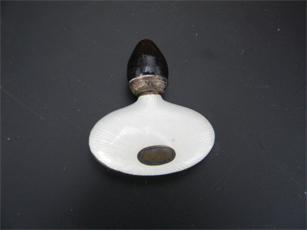featured item

quality pair of antique edwardian postal scales and weights Read more
Fabergé Eggs
Posted by Gill Jones on 14/02/2017
Once upon a time in Russia (and I’ve always wanted to say that), there was a jeweller/artist/goldsmith working for the Russian Imperial Court. He would go on to create the world-famous Faberge egg, named after himself of course. Yes, Faberge eggs are for the rich. All his eggs were and still are decorated with the finest jewels and the most precious objects imaginable. They are symbolic of a dynastic and passionate world for which there is no equivalent today. They embody the world from which they came.
Faberge himself was born in the middle of the 19th century and travelled the world before settling down to a goldsmith course in France, England and Germany. He learnt his craft well, and his exquisite eggs were representative of his talent and dedication to even the minutest of details.
So, what can you expect from a Faberge egg?
Like a Kinder egg, but oh-so-much better than a Kinder egg, a Faberge egg often contained a surprise, and more often than not that surprise was even better than its container – if that’s even possible. It could be a clockwork toy or a miniature train, and always bejewelled to the nth degree like the egg it sat in. Yes, they were commissioned by the Russian Royal family and they passed them on to each other as presents, and apparently, there were only ever 50 made and only 43 survive. So, getting your hands on an original is not only going to be a rare occurrence it’ll also be very, VERY expensive.
But, what about any new Faberge eggs, because the Romanov family no longer exist, so it’s not as if they can commission any new ones, is it?
No, they can’t but the Faberge brand and its current owners create new eggs and call them Imperial Class eggs, making them the first since the early part of the 20th century.
Faberge was once owned by Unilever, before being sold on to Pallinghurst Resources, and they then relaunched back in 2009 with Faberge’s grandchildren at the helm. In 2012 they were bought by Gemfields, which is just as well, as they own previous stone mines and know an awful lot about gems. Of course, Pallinghurst still retains a stake in the company.
So, what happened to those original 43 Faberge eggs?
As you can imagine they are as rare as an original Van Gogh, and they are THE ultimate find for antique lovers the world over. Apparently, the queen owns at least 3 of the Imperial Eggs which form part of the Royal Collection. One of the most famous of the 3 owned is the Mosaic egg which was designed exclusively for Tsarina Alexandra. And yes, there was a secret gift inside, a miniature medallion with pictures of the children, it was snapped up by a clever King George V in London for the princely sum of £250.
The rest are apparently still in Russia with an oil and gas tycoon buying $100 million for 9 of them, and 10 being bought by the Kremlin Museum in Moscow. Others are scattered all over the world, mostly in American museums.
The oldest and first Faberge egg was the Hen Egg. Simple, with white enamel, but inside was a yolk made from solid gold with a golden hen sitting within the yolk. And yes, there were more gifts inside the hen, two in fact. One was an exquisitely identical miniature of the Royal Crown and the second was an egg pendant, with a tiny ruby egg. Unfortunately, these gifts went missing.
The Hen Egg was made in the latter half of the 19th century and commissioned by Alexander III, and of course it’s now owned by that very same, very lucky and very rich Russian oil and gas tycoon we mentioned earlier.
Unfortunately, here on www.antique.co.uk we do not have any of the 43 remaining Faberge eggs on sale, if we did, they wouldn’t be there very long. However, we do have an antique ‘Faberge’ style egg fob/pendant from the mid-20th century made from 18ct gold. If you fancy a little of the Faberge magic, it wouldn’t be a bad place to start.
Take a look around our directory, www.antiques.co.uk and see if you can find yourself a similar beauty, or perhaps some antique egg cups, which are equally beautiful but not Faberge inspired.
Take care from us all at www.antiques.co.uk and a very happy Easter




